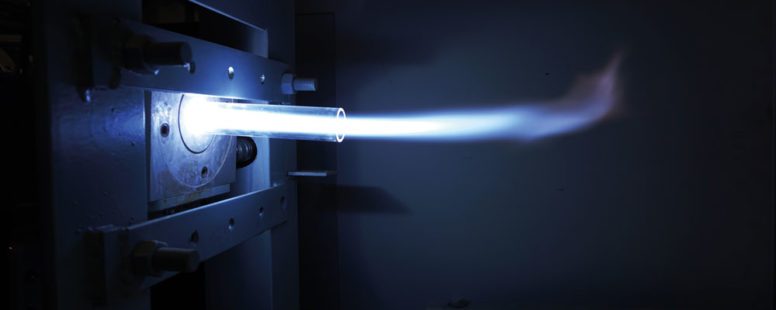Plasma burners
EBNER.blog | Werner Wiggen, TPS
Plasma burners.
TPS has developed a zero-CO2 alternative to common gas-fired burners.
Even though aluminum is a metal that, due to its low weight and the ease with which it can be recycled, is both important for and well-suited for many future products, its current carbon footprint is still high.
The higher the proportion of recycled material in a given mass of aluminum, the greater the impact of the carbon footprint of the melting process on overall emissions. At major facilities, the most current melting technology employs a gas-fired heating system equipped with regenerative burners. Even though these burners can operate extremely efficiently, consumption values of 550 – 600 kWh/t are not unusual. The combustion of natural gas releases 0.2 kg of CO2 for each kWh of energy, which in turn means that 120 kg of CO2 are released for each metric ton of aluminum that is melted. However, this does not take into account the emissions generated upstream, in the supply chain for the fuel gas (natural gas). These can add an additional 30 % to the emissions generated by combustion.
ZERO-CARBON ALTERNATIVES
A wide variety of zero-carbon alternatives for heating industrial processes are known. For example, many processes can be heated in a carbon-neutral manner by using an electrical resistance heating system. However, the power density offered by such a system is inadequate for melting aluminum on a large scale. Furthermore, a melting process using induction leads to other problems when melting aluminum.
While induction furnaces with capacities up to 5 metric tons are suitable alternative designs, their weaknesses in areas such as ease of maintenance and process flexibility become ever more apparent as the furnaces are scaled up. For example, a casthouse that would like to replace a 100-ton round-top melting furnace would have to adapt all of its downstream processes to suit the new furnace design.
Another technology that can be employed at existing facilities is hydrogen combustion. However, a number of issues also inhibit the widespread use of this fuel. While on the one hand it is unclear when and if an adequate and affordable infrastructure will be available, it is also unclear at this time whether the use of hydrogen will have a negative impact on metallurgical properties. Hydrogen inclusions and the formation of aluminum oxides are critical issues to consider.
PLASMA BURNERS: A POSSIBLE ECO-FRIENDLY SOLUTION
Another technology that is both eco-friendly and capable of fulfilling requirements is that used in what are known as plasma burners. Conventional plasma burners generate an arc between a cathode and an anode, which heats a gas and so creates plasma. However, this technology has a disadvantage in that, due to the extremely high temperatures that develop, the service lives of cathodes and anodes are very limited.
TPS chose to meet this exciting challenge head on, and develop a plasma burner both suitable for industrial applications and that would use induction to create plasma. This would have the advantage that critical components would not come into contact with the plasma, as the plasma itself would heat and melt the aluminum.
Using this technology, it would be possible to melt aluminum using a carbon-neutral method. One of the major factors considered in the design is that this technology would need to be capable of being installed at existing facilities equipped with gas-fired combustion systems. That is, the plasma burners must be able to replace the gas burners of the old system. A further advantage offered by the design is that the technology can be employed in flexible furnace atmospheres. As the presence of oxygen in the furnace is eliminated, the amount of dross that is created can also be reduced.
TPS developed this technology in cooperation with well-known project partners.
By the end of 2023, the first conclusive results comparing the technology’s influence on metallurgical characteristics to that of natural gas and hydrogen burners should be available. These results will be gathered using a laboratory furnace capable of processing charges up to 200 kg. The first installation under industrial conditions is planned to take place in 2025.
- 100 % CO2-free -> zero emissions
- Easy to integrate into existing facilities
- Can be operated in flexible furnace atmospheres
- Reduced dross
- Developed in a cooperative effort with well-known institutions
Plasma burners



